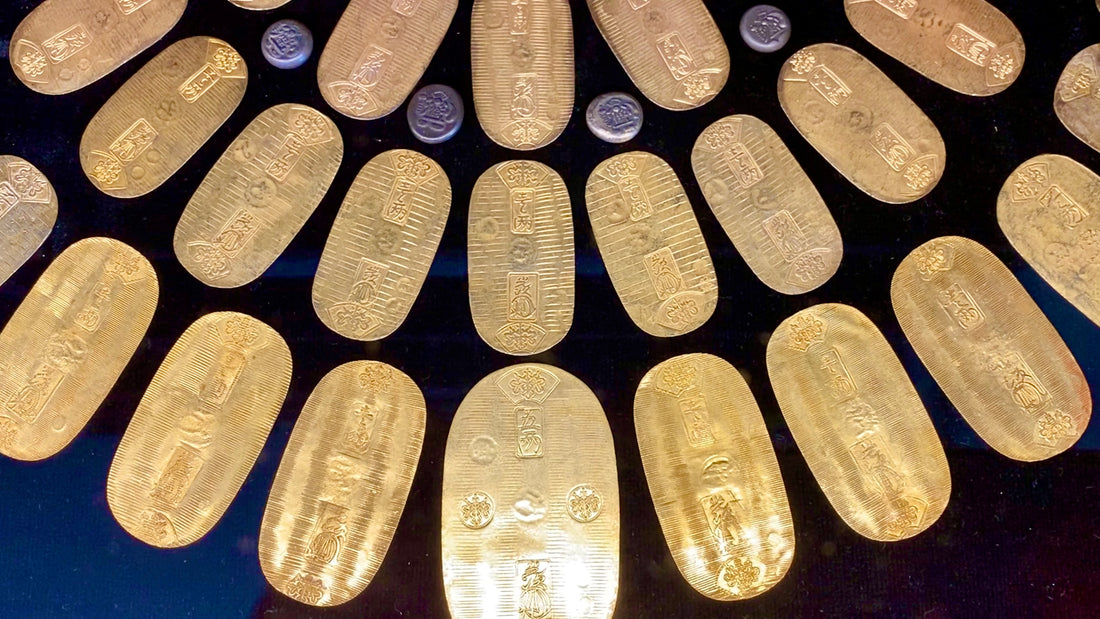Koban was a traditional Japanese currency, a gold coin that was used for approximately 260 years from beginning of the Edo period to the early Meiji period (1601-1867).
Kobans were minted very thin to prevent counterfeits that were not solid gold inside. Furthermore, the horizontal cut marks on the obverse make the insides visible which proves a Koban is solid gold. In the early Keichō period when Kobans began, a craftsman took the time to neatly hammer thin cuts into the entire obverse with a flat head hammer. As this was lowering the productivity of the craftsmen, this process was changed to making coarse cuts covering less of the obverse which took much less time. The coarse cuts became the standard for all Kobans thereafter.
During the Edo period, Koban were mainly used by the upper classes such as daimyo (feudal lords) and wealthy merchants. The value of a Koban was based on the gold-silver exchange rate, and its value fluctuated depending on the era and economic conditions. Generally, Koban were treated as high-value currency and were used for large transactions and the purchase of luxury goods.

Now, let's look at the characteristics of Koban across different eras.
⚫️Keicho Koban (慶長小判)
The "Keicho Koban" is a gold coin first issued in 1601 (the 6th year of the Keicho era), during the early Edo period in Japan. It continued to be minted for an extended period of approximately 94 years.
One notable characteristic of the Keicho Koban is the intricate matting pattern (Gozame) that was embossed onto the entire surface during the forging process. As the years progressed, the Koban made in the early Keicho period saw the pattern's individual strokes gradually widen due to efficiency measurements. However, they were still meticulously and densely embossed compared to those in the later periods.
In addition, the Keicho Koban boasted the highest gold purity among its counterparts at 85.6%, making it a remarkably superior currency for its time.

⚫️Genroku Koban (元禄小判)
The "Genroku Koban" was a gold coin issued in 1695 (the 8th year of the Genroku era). Its period of issuance was relatively short, ending in 1710. The character "Gen (元)" was engraved on the reverse side.
During this era, the shogunate was grappling with financial difficulties, and the amount of gold mined had drastically decreased, rendering the issuance of Koban nearly impossible. To maintain the quantity of Koban in circulation, the gold content was reduced.
As a result, the Genroku Koban had a gold purity of only 56.41%, about 30% lower than that of the Keicho Koban. Despite its inferior durability, it had a significant presence, playing a crucial role in supporting the economy during the Edo period.
⚫️Hoei Koban (宝永小判)
The "Hoei Koban" is a gold coin that was only issued for about three years starting from 1710 (the 7th year of the Hoei era). The character "Kan (乾)" is engraved on the reverse side.
In an attempt to improve the low quality that became a problem with the Genroku Koban, the gold purity was restored to 83.4%. However, due to the ongoing gold shortage, the size of the Koban was reduced. Consequently, a distinguishing feature of the Hoei Koban is that it is noticeably smaller than the Genroku Koban.
⚫️Shotoku Koban (正徳小判)
The "Shotoku Koban" is a gold coin that was issued in 1714 (the 4th year of the Shotoku era).
Born out of a proposal by Arai Hakuseki (politician) to return the low-quality Koban to their original quality, it successfully achieved a gold purity of 85.7%. However, in practical terms, its quality was inferior to the Keicho Koban and it received a succession of negative reviews, leading to a cessation of issuance after only four months.
⚫️Kyoho Koban (享保小判)
The "Kyoho Koban" is a gold coin that was issued in 1714 (the 4th year of the Shotoku era). The name "Kyoho" corresponds to the following era name, which was likely assigned to distinguish it from the prematurely discontinued Shotoku Koban.
The Kyoho Koban was issued with the intent of achieving high-quality Koban by using lower quality Genroku and Hoei Koban as materials.
It successfully recovered the gold purity to 86.1%, the same as the Keicho Koban. However, this led to a decline in the quantity of currency in circulation, causing damage to the overall economy.
⚫️Genbun Koban (元文小判)
The "Genbun Koban" is a gold coin that was issued in 1736 (the first year of the Genbun era), under the command of the 8th Shogun, Tokugawa Yoshimune. The character "Bun (文)" is engraved on the reverse side in regular script.
At the time, the economy was in distress and an increase in Koban was necessary for stabilization. However, due to the declining amount of gold available each year, Genbun Koban of poor quality with a gold purity of 65.3% were put into circulation.
While criticism was anticipated from previous failures, the measure was successful and contributed to stabilizing the economy. The issuance period of approximately 90 years was the second-longest after the Keicho Koban.
⚫️Bunsei Koban (文政小判)
The "Bunsei Koban" is a gold coin that was issued in 1819 (the 2nd year of the Bunsei era). The character "Bun (文)" is engraved on the reverse side in cursive script.
Among the Koban issued during the Edo period, the Bunsei Koban has the lowest gold purity at 55.9%.
⚫️Tenpo Koban (天保小判)
The "Tenpo Koban" is a gold coin that was issued in 1837 (the 8th year of the Tenpo era). The character "Ho (保)" is engraved on the reverse side. From this era, the gold flattening process was changed from handwork to rollers, resulting in a beautifully finished Koban without unevenness.
However, as gold was still scarce, the gold purity remained low at 56.8%.
⚫️Ansei Koban (安政小判)
The "Ansei Koban" is a gold coin that was issued in 1859 (the 6th year of the Ansei era). The character "Sei" is engraved on the reverse side.
At the time, Japan had just opened to the world, and large amounts of Koban were being massively exported overseas in exchange for foreign silver. To deter this, the smaller Ansei Koban, maintaining a gold purity of 56.8%, was issued. However, facing opposition from the United States, the issuance was halted after just three months.
⚫️Manen Koban (万延小判)
The "Manen Koban" is the last Koban of the Edo period, issued in 1860 (the first year of the Manen era). Compared to other Koban, its size is extremely small, and due to its resemblance to a chick, it is also called "Hina Koban (雛小判)". This effectively reduced the amount of gold.

As a result, it achieved a value equivalent to foreign silver, successfully suppressing the outflow of gold overseas. However, in exchange, the shogunate lost control, marking the end of the Edo shogunate.


